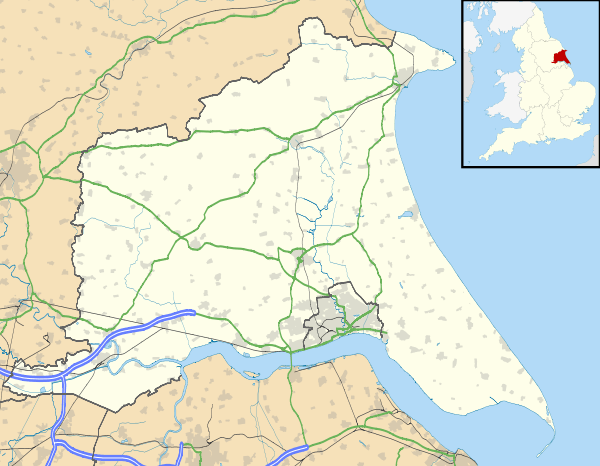Church of St Helen, Kilnsea
| St Helen's Church | |
|---|---|
| Church of St Helen | |
 | |
 St Helen's Church | |
| Coordinates: 53°37′11″N 0°07′54″E / 53.619736°N 0.131785°E | |
| Location | Kilnsea, Holderness, East Riding of Yorkshire |
| Country | England |
| History | |
| Founded | 1864-5 |
| Architecture | |
| Functional status | Redundant |
| Architect(s) | William Burges |
| Architectural type | Church |
The Church of St Helen, Kilnsea, Holderness, East Riding of Yorkshire, England, is a redundant parish church dating from 1864–5. It was designed by the architect William Burges.
History
The hamlet of Kilnsea lies in the parish of Easington, almost at the tip of Spurn Head, in the East Riding of Yorkshire. The hamlet has always been prone to sea erosion and the original church of St Helen fell into the sea in 1831.[1] Some thirty years later, on 22 April 1865, the Yorkshire Gazette recorded; "the great liberality of Mr. A. Burgess C.E., of Blackheath, who having occasionally passed (Kilnsea) on his professional visits to Spurn Point and struck with the poverty of the place, having heard that an effort was being made for building a church, most kindly offered plans free of all expense, and gave £150 towards its completion".[2] Pevsner notes that the plans were drawn up by Alfred Burges's two sons, "one of whom was the architect William Burges".[1] The purpose of Alfred Burges's "professional visits" to Spurn Point is unclear, but his partner in the engineering firm of Messrs. Walker and Burgess, James Walker, was Chief Engineer for Trinity House, the body with responsibility, then and now, for lighthouse construction in Great Britain.[3] In the 1850s, Trinity House funded the construction of a new lighthouse at Spurn Point, the Low Lighthouse.[4]
The total cost of the new church was £420.[1] The church was declared redundant in 1993 due to falling congregations, the last service being held on 20 June of that year.[5] It was subsequently sold, with the intention of conversion to a private house.[5]
Architecture and description
The church is simple and small, comprising a chancel, nave and bellcote.[1] It is constructed of red and yellow brick and incorporates some material from the earlier church.[1] The building is not listed[6] and is not recorded in the gazeteer of Burges's known buildings compiled by the architectural historian J. Mordaunt Crook, and included as Appendix B in his study of Burges, William Burges and the High Victorian Dream.[7]
Notes
- 1 2 3 4 5 Pevsner & Neave 2005, p. 577.
- ↑ "Consecration of a new church at Kilnsea". Yorkshire Gazette. 22 April 1865. p. 4 – via British Newspaper Archive. (Subscription required (help)).
- ↑ "Lighthouses". Trinity House. Retrieved 26 June 2017.
- ↑ Baker, Geoffrey. "Foghorn Publishing ... Lighthouse Explorer Database ... Spurn Point Low Light". www.lighthousedigest.com. Retrieved 26 June 2017.
- 1 2 "Human Bones at Kilnsea". www.wilgilsland.co.uk. Retrieved 26 June 2017.
- ↑ "The List Search Results for Kilnsea". historicengland.org.uk. Historic England. Retrieved 26 June 2017.
- ↑ Crook 2013, p. Appendix B.
References
- Crook, J. Mordaunt (2013). William Burges and the High Victorian Dream. London: Frances Lincoln. ISBN 978-0-7112-3349-2.
- Pevsner, Nikolaus; Neave, David (2005). Yorkshire: York and the East Riding. The Buildings of England. New Haven and London: Yale University Press. ISBN 0-300-09593-7.
